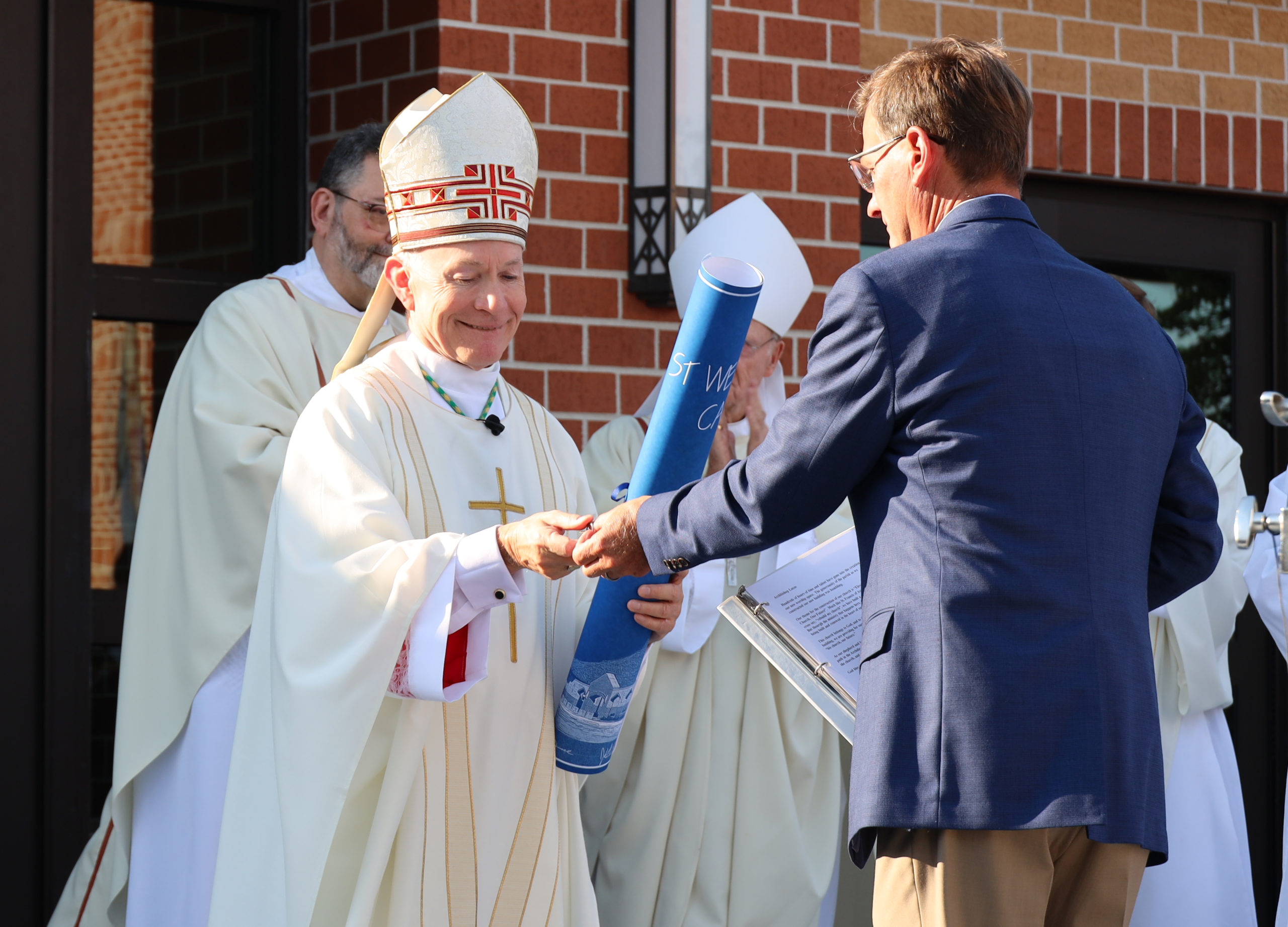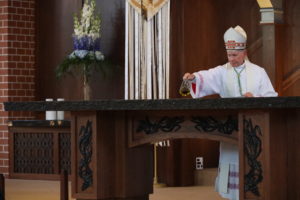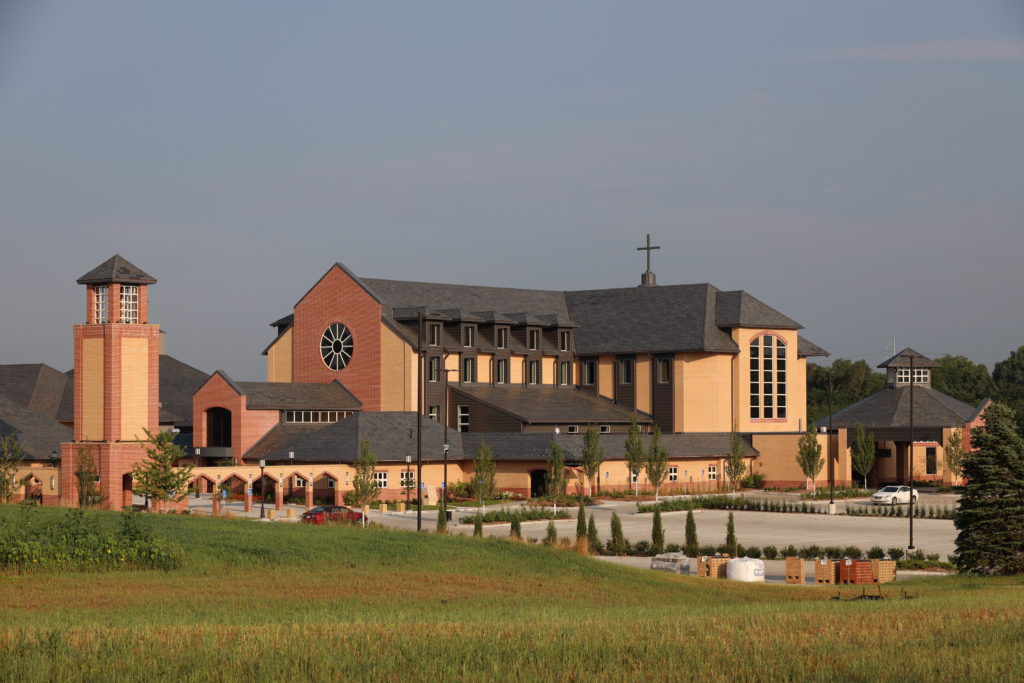
Parishioner and building committee chairman Ed Thiele presents Archbishop George J. Lucas with the blueprints and key to the new St. Wenceslaus Church in Omaha in a ceremony outside the church July 1. The archbishop next presented the blueprints and key to Father Thomas Bauwens, pastor, before beginning a Mass to dedicate the church. MIKE MAY/STAFF
News
New St. Wenceslaus Church a ‘grace from God’
July 14, 2021
Father Tom Bauwens could see the influence of Divine Providence at work.
From a huge unsolicited donation by a longtime friend to the well-timed availability of an adjoining plot of land, along with the generosity and commitment of parishioners, the construction of the new St. Wenceslaus Church in Omaha is “a grace from God,” the pastor said.
The new church – seven years in the planning, fundraising and construction stages – was dedicated by Archbishop George J. Lucas July 1 before a capacity congregation of 1,400 parishioners, priests and guests.

Archbishop Lucas consecrates the new altar with holy oil before beginning the Liturgy of the Eucharist. MIKE MAY/STAFF
It all began eight years ago with a suggestion from Eileen Ryan, a longtime friend of Father Bauwens.
Ryan, who found the church’s physical characteristics, such as its tiered parking lot, numerous steps and sloping entrance, difficult to navigate due to her physical disabilities, often suggested ways to make the church more handicap-accessible, ways that were not possible due to various constraints, Father Bauwens said.
“So, she said, ‘What do you need to build a new church?’ and I said, ‘About $10 million.’ And she gave us $10 million.”
The donation, through the charitable foundation of Ryan and her husband, Wayne, both now deceased, provided the seed money to get the project started. Planning soon began with numerous input-gathering meetings involving parishioners and the organization of a building committee and subcommittees.
A short time later, the parish also had the opportunity to buy 16 acres of land that had been part of the former DeMarco family farm to the east of the parish campus, said Ed Thiele, parishioner and building committee chairman.
When the farm was sold for future residential and commercial development, the DeMarcos stipulated that a portion must be made available to the parish for future expansion, he said.
MEETING THE NEEDS
As one of the largest parishes in the archdiocese, with 3,361 families and 12,912 members, St. Wenceslaus had already outgrown its 37-year-old, 800-seat church. It also lacked adequate office and meeting space for its many activities and ministries, Thiele said.
Further considerations included new residential development with 2,300 units being constructed nearby – which could add a projected 7,000 parishioners – and a projected decline in numbers of priests. All these factors led the parish to look long term at how to serve its growing population.
“Father Tom was always pretty visionary, challenging us that we’re building for the next hundred years, so we can’t be short-sighted,” said Kevin Strehle, principal with BCDM Architects, the church’s designers.
Now, with seating for 1,400, the new church is the largest Catholic church in Nebraska, making possible fewer but larger weekend Masses should the parish have fewer priests in the future, Strehle said.

The new St. Wenceslaus Church in southwest Omaha nearly doubles the capacity of the previous church, becoming the largest Catholic church in Nebraska. MIKE MAY/STAFF
Another priority was access, especially given Nebraska winters, he said. That’s why the church includes a covered, drive-thru entrance to drop off worshippers and heated walking surfaces in the courtyard. Entrances and parking, including 23 handicap spaces, also are now on one level.
DESIGN ELEMENTS
In addition to size, much thought went into both practical and aesthetic aspects of the worship space, Strehle said.
Building committee members visited numerous area churches for ideas, he said, including St. Patrick in Fremont, St. Vincent de Paul and St. James in Omaha, and St. Patrick in Gretna.
In contrast to the simpler styling of the previous church, parishioners had expressed a preference for a more traditional and ornate worship space, Father Bauwens said.
So, notable design elements include wooden ceiling beams, a mosaic-adorned baptismal font, traditional stained glass windows, and a more dignified sanctuary area.
“I just believe, when people come in now, they really feel that this is a Catholic church,” he said.
And with seating that arcs around the sanctuary on three sides, no one will be too far from the altar, Father Bauwens said.
“We have a very warm, welcoming community and really believe Christ is at the center of it,” he said. “I think this is going to help us magnify that a bit.”
Other features include a 200-seat chapel for daily Mass and smaller weddings and funerals, eucharistic chapel, Bluetooth connectivity for people with hearing aids, geothermal heating and air conditioning, a courtyard and bell tower, and 5,000 square feet of office and meeting space.
PARISHIONER GENEROSITY
After the Wayne and Eileen Ryan Foundation’s $10 million donation, the parish embarked on a capital campaign to finance another portion of the $30.2 million total cost of the project.
In two stages, the parish raised another $14 million, with individual donations ranging from $10 to $1.5 million. The balance is covered through bank financing.
“The response has been really remarkable,” said Lisa Daub, co-director of development for the parish. “We were extremely blessed by the generosity and the sacrifices that people were making during such a difficult time (the pandemic),” including from longtime parishioners whose membership dates back to two churches ago.
“St. Wenceslaus is their family, and even in the most difficult times, you do what you need to do to support your family.”
And parishioner generosity didn’t stop there. Parish families donated the new organ, ambo and landscaping, among many other items.
And numerous parish volunteers donated their own time and labor to see the project through, maintaining landscaping, moving the parts of the old organ to the day chapel, cleaning and other tasks.
“It’s amazing … and encouraging how people step up, not only financially, but when you need help,” Thiele said. “It’s really great.”
TRUE TO ITS HERITAGE
While looking to the future, planning and construction also paid tribute to the history and heritage of St. Wenceslaus Parish, founded in 1877 as a national Czech parish.
“We are a national Czech parish, still,” Father Bauwens said. “Until we moved out here in 1981 and built the church in 1984, it was predominantly Czechs who belonged to the parish.”
So, to honor that history, the new church includes a painting of St. Wenceslaus, stained glass window of St. John Nepomucene and statues of Ss. Cyril and Methodius, all from the second St. Wenceslaus Church, built more than 130 years ago near downtown Omaha.
Although there are fewer full-blooded Czech parishioners today, the people who worked to make the parish successful over the years are part of its history, Father Bauwens said.
“We believe you’re a parishioner even after you die,” he said. “You’re still part of the parish family.”